Salah Al Din Metro Station: Architecture and Urban Impact
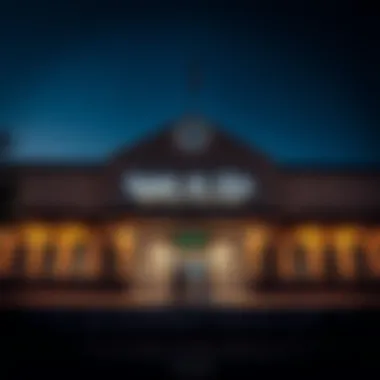
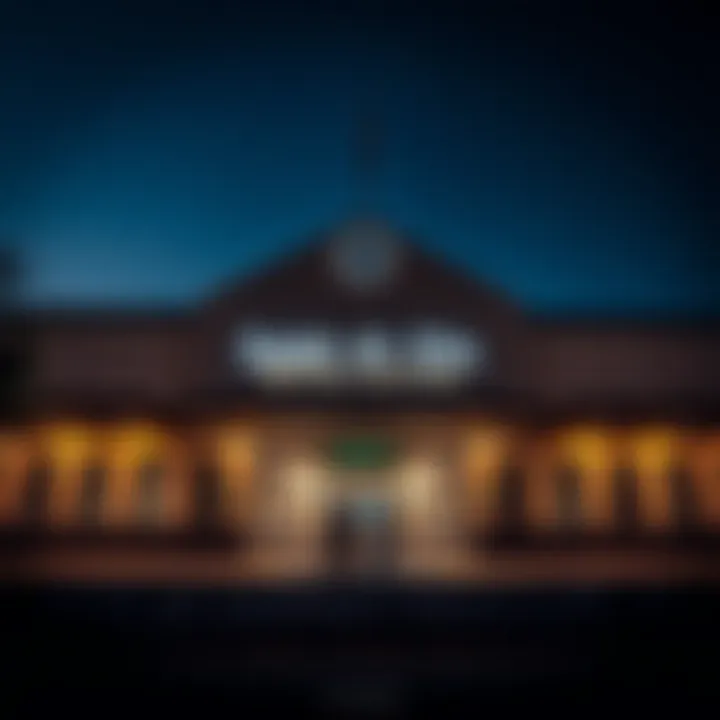
Intro
Salah Al Din Metro Station stands as a keystone within Dubai’s sprawling urban framework, deftly merging architectural splendor with functional necessity. The station is not simply a point of transit; it is imbued with the very essence of urban development, reflecting both the history and aspirations of this dynamic city.
Nestled at the heart of Dubai, this station provides vital connectivity to the northern regions while simultaneously linking to the vibrant commercial and residential hubs nearby. As urban landscapes continue to change and grow, understanding the significance of such transport infrastructure becomes essential, especially for real estate enthusiasts and investors keen on capitalizing on emerging opportunities.
In this article, we will take a thorough look at Salah Al Din Metro Station—not just its sweeping architectural design and operational feats, but also its impact on the surroundings. We will examine market trends, investment insights, and the future outlook of the areas adjacent to the station. By engaging with this content, readers will emerge with a deeper appreciation for both the physical structure and its broader implications on the real estate market in Dubai.
Let's begin by diving into the vital market trends that shape the region.
Foreword to Salah Al Din Metro Station
Salah Al Din Metro Station stands as a beacon of connectivity within Dubai’s sprawling urban fabric. This station plays a crucial role in enhancing the public transport puzzle of the city, enabling thousands to navigate seamlessly through a bustling metropolis that never sleeps. Its strategic location offers a lifeline not just to everyday commuters but also to tourists exploring the fascinating blend of modernity and tradition that defines Dubai.
At its core, the importance of Salah Al Din Metro Station can be attributed to its accessibility and efficiency. It's strategically situated near key commercial districts, shopping centers, and other essential amenities. This makes it an invaluable asset for investors and homeowners alike who are considering properties in close proximity. The station’s design isn’t just about aesthetics; it’s about enhancing mobility and easing traffic woes, which benefits the local community significantly.
Moreover, the station embodies modern architectural principles while adhering to the region's cultural context. It serves as a visual landmark, making a significant impression on passerby and enhancing the overall urban landscape. The design integrates functionality with art, showcasing how transport systems can enhance city life.
Public metro systems, especially those as pivotal as Salah Al Din, contribute to lowering carbon footprints by promoting the use of mass transit over personal vehicles. As the world tilts toward sustainability, it’s imperative to recognize the positive environmental impact of the station. The benefits extend beyond individuals; communities thrive economically when mobility improves, resulting in local businesses experiencing more foot traffic, thereby enhancing their viability.
Therefore, understanding Salah Al Din Metro Station is essential for anyone engaged with Dubai’s real estate market. From investors to urban planners, the station represents a fusion of opportunity, community engagement, and a gateway to better urban life. Its direct connection to the broader metro network alludes to the vast possibilities awaiting within reach, further entrenching its importance as a major transit hub. As one navigates through the developments surrounding the metro, it becomes increasingly clear that Salah Al Din is much more than a transport facility; it is a vital cog in the wheel of Dubai’s urban evolution.
Architectural Design and Aesthetics
Architectural design and aesthetics play a pivotal role in shaping not only the physical space but also the experience that individuals have within these environments. Salah Al Din Metro Station stands as a prime example of thoughtful design married to functionality, reflecting a broader vision of urban transport within Dubai. The aesthetics seen here extend beyond mere visual appeal—they encapsulate the spirit of the city, bridging tradition and modernity. Through this exploration, we delve into how the station delves into this relationship, ensuring that it not only serves its purpose but does so in a manner that resonates with the local culture and promotes a sense of identity.
Overview of Modern Designs
When one looks at Salah Al Din Metro Station, it's hard to ignore how modern designs meld seamlessly with the traditional aesthetics of Dubai. This station embodies a design philosophy that emphasizes clean lines, open spaces, and abundant natural light. The architectural layout is deliberate; allowing for smooth movement of commuters while also permitting various visual touchpoints that enhance the overall experience.
- Integration with Urban Context: The station is strategically positioned to facilitate easy access for not just daily commuters but tourists as well, underscoring its role in the local landscape.
- Innovative Solutions: The use of contemporary design elements, such as glass facades and nature-inspired motifs, proves pivotal, as these features not only promote efficiency but also create a visually stunning environment.
In an era where urban transit hubs need to cater to both functionality and aesthetics, Salah Al Din Metro Station sets a precedent that avid designers might reference in their own projects.
Materials Used in Construction
The choice of materials in construction is crucial, influencing both the durability of the structure and its visual appeal. Salah Al Din Metro Station utilizes high-quality materials that ensure the station withstands the test of time while complementing its innovative design.
- Concrete and Steel Framework: These fundamental materials provide the necessary strength and stability. Their properties allow for expansive structural elements that form the backbone of the station.
- Glass and Composite Panels: The incorporation of glass is twofold; it enhances natural lighting and gives the station an elegant, modern look. Composite panels add texture and color, which enriches the visual landscape.
Each material is meticulously chosen not just for its performance but also for conveying an image of sophistication. The implications of these material choices reflect ongoing trends towards sustainability and energy efficiency within urban projects.
Visual Elements That Define the Space
The visual elements of Salah Al Din Metro Station encapsulate a language of design that speaks to both visitors and locals alike. These elements do more than decorate; they inform, guide, and inspire.
- Color Palette: The carefully chosen colors are reminiscent of the natural hues found in the Dubai landscape, linking the built environment to its geographical context.
- Art Installations: Integrating artistic pieces throughout the station not only decorates the space but also instills a sense of local identity and culture—these installations tell the stories of Dubai's heritage.
- Lighting Design: Thoughtfully oriented lighting fixtures play a vital role, transforming the station into a welcoming space throughout the day and night. The interplay of shadow and light enhances architectural features, inviting users to engage with their surroundings more profoundly.
In summary, the visual elements at Salah Al Din Metro Station create an immersive experience that fosters community engagement and appreciation for the architectural narrative being told. Each detail, from materials to lighting, contributes to the station's overarching aesthetic vision.
Significance of the Metro Station
The Salah Al Din Metro Station serves as a vital cog in the expansive transport network of Dubai, presenting significant benefits to urban mobility and local property values. This nexus of transportation not only streamlines the movement of people across the bustling city but also embodies greater implications for the real estate landscape in the area. This section will delve deep into the various dimensions of its importance, making it clear why it deserves attention from investors and locals alike.
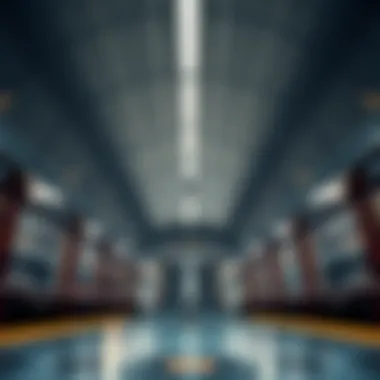

Role in Urban Mobility
Salah Al Din Metro Station plays a crucial role in enhancing urban mobility. It serves as a linchpin for commuters, connecting various neighborhoods with major commercial hubs. With the metro system designed to alleviate traffic congestion, it offers a seamless alternative to road travel. One can witness daily, how throngs of commuters, from working professionals to students, utilize the station to navigate efficiently. This ease of access bolsters the overall productivity of the workforce.
Moreover, the station promotes sustainable transport solutions by encouraging more people to choose public transportation over personal vehicles. This shift is essential for reducing carbon footprints and easing traffic jams on Dubai's busy roads. In a city often associated with elaborate infrastructure, the significance of such stations cannot be overstated, particularly when we consider the broader context of climate consciousness sought by global cities today.
"Public transport systems are the veins and arteries of any urban environment, essential for creating a vibrant and interconnected community."
Influence on Local Real Estate
The arrival of the Salah Al Din Metro Station has undeniably had an impact on local real estate dynamics. Property values in the vicinity often rise when efficient public transport is made available. Investors, agents, and homeowners recognize the inherent value in purchasing properties near transport hubs, aware that such locations provide not only convenience but also a potential for substantial capital appreciation.
The proximity to the metro station often leads to increased demand for residential properties, making them particularly appealing for expatriates and families seeking comfort and practicality. Studies frequently indicate that areas adjacent to metro stations can experience property value increases ranging from 10 to 15% over a relatively short period following the opening of such facilities. This trend highlights the strategic advantage for real estate investors aiming to capitalize on developing neighborhoods.
In addition, local businesses often benefit from increased foot traffic around such stations. Restaurants, cafes, and retail outlets flourish as more people pass by, creating a vibrant economic ecosystem. The synergy created between residential expansions and commercial enterprises reinforces the idea that metro stations are more than transport nodes; they are economic catalysts that stimulate growth in numerous sectors.
Connection to Other Transit Lines
Another notable significance of the Salah Al Din Metro Station is its connectivity to other transit lines. The strategic placement of this metro stop is part of a larger framework aimed at facilitating fluid transitions between various forms of transportation, be it the bus service, taxi networks, or even burgeoning ride-sharing platforms. This interconnectivity is essential, as it allows riders to consolidate their journeys with ease, making commuting a more attractive option.
Furthermore, linking to other metro lines expands the reach of Dubai’s public transport network, removing barriers to travel across the city. For the business sector, this means employees can commute more efficiently, accessing a wider range of job opportunities without the need for lengthy travel. In turn, this bolsters the local economy and engenders a competitive marketplace.
In essence, the Salah Al Din Metro Station exemplifies how integration within transport networks can enrich the urban experience. This coherence between systems is not just a logistical convenience; it signifies the overarching vision of Dubai as a world-class city committed to enhanced connectivity and mobility.
With all these interconnected factors, the significance of the Salah Al Din Metro Station becomes crystal clear, intertwining urban mobility, real estate dynamics, and transit connectivity. Investors keen on tapping into the pulse of Dubai’s development cannot afford to overlook the effects of such a pivotal transport facility.
Photographic Showcase
The photographic showcase serves as a pivotal part in highlighting the artistic and operational beauty of Salah Al Din Metro Station. Photos do more than simply speak; they narrate a story of design, function, and community engagement. Through visual elements like textures, colors, and structural lines, we can achieve a deeper appreciation of this urban landmark. These images aid investors, agents, expatriates, and homeowners in visualizing potential property opportunities and understanding the commuting experience in the area.
Great photographs can elevate the surrounding narrative, drawing the reader in and encouraging them to delve deeper. They encapsulate the ambiance of the station and its integration into the urban fabric of Dubai. Thus, it is essential to present a variety of shots, each capturing a different aspect of the station’s significance.
Exterior Shots
The exterior shots of Salah Al Din Metro Station provide a first impression of its relationship with the cityscape. Captured from various angles, these photos bring to life the grandeur of the station’s façade. The combination of sleek lines and modern materials creates a striking silhouette against the backdrop of Dubai's skyline.
Color plays a significant role here. The station’s exterior often reflects the changing sunlight, making it look different throughout the day. Shadows, reflections, and the surrounding street life offer an immersive experience. When capturing these images, the focus should not solely be on the station but also its interaction with nearby structures and the architectural harmony of the area, reinforcing the significance of public transport.
Some key elements to look for in exterior shots include:
- Unique architectural features: Arched entrances, glass barriers, and decorative elements give character.
- Accessibility: Ramps and pedestrian pathways show how welcoming the station is for all.
- Landscaping: Trees, benches, and surrounding plazas enhance the station's aesthetic and functional significance in urban mobility.
Examples of External Shots:
- Wide-angle views showing the station in context.
- Close-ups of design elements that speak to modern engineering.
Interior Perspectives
Once inside the station, the perspective shifts dramatically. Here, the functionality meets design in the most practical way. Interior shots should showcase the spaciousness and flow of the station, emphasizing how comfortably the daily commuters can navigate through space.
Lighting inside the station is crucial—natural light streaming through large windows creates an inviting atmosphere, while artificial lighting enhances safety and visibility during nighttime operations. Art installations or patterns in flooring can also serve as focal points, providing a sense of identity to the space.
Factors to consider:
- Commuting experience: Images displaying crowd movement can convey the efficiency and traffic flow.
- Amenities: Pictures of waiting areas, ticket counters, and shops highlight the services provided.
- Safety features: Emergency exits and signage are critical in depicting the station's priorities in user safety.
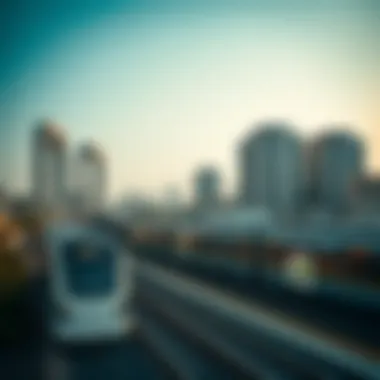

Examples of Interior Shots:
- Photos capturing commuters interacting with the environment.
- High-angle views showing the layout and organization of the interior space.
Surrounding Environment
Photographs of the surrounding environment present a broader perspective on how Salah Al Din Metro Station fits into its urban context. These shots map out the connectivity of the station to surrounding amenities and neighborhoods. Capturing areas around the station—local shops, cafes, and public spaces—can provide insights into lifestyle benefits for potential investors and residents.
In examining locations surrounding the station, some elements are worth focusing on:
- Accessibility to public spaces: Parks, plazas, and gathering points.
- Commercial developments: How retail or office spaces nearby might impact the station’s value.
- Transit connections: Additional lines or bus stops that contribute to the area's overall transport network.
Using these photographs in conjunction with others can create a rich visual context that highlights the vibrancy of the area. Potential investors are especially keen on how the environment interacts with the metro station, as this underscores the potential for property value increases and lifestyle enhancement.
Examples of Surrounding Environment Shots:
- Shots capturing life outside the station.
- Aerial views that show connectivity between multiple transport lines and local developments.
Comparative Analysis with Other Metro Stations
In evaluating the Salah Al Din Metro Station, it is crucial to place it within the broader context of other metro stations globally. This comparative analysis offers insights into design, functionality, and the economic implications of transit hubs. Understanding the distinctive features and successful narratives of similar stations can inform potential investments and developments in the area surrounding Salah Al Din. The goal here is not just to appreciate what sets the station apart, but also to ascertain how it fits into the larger framework of urban transportation and real estate.
Key Differentiators
Salah Al Din Metro Station stands out in several ways compared to its counterparts in various cities. Here are some notable differentiators:
- Design Philosophy: Many metro stations focus primarily on functionality. However, Salah Al Din has embraced a design that harmonizes with the surrounding architecture of Dubai, reflecting both modern aesthetics and cultural heritage. This blend makes it not just a transit point, but a landmark in its own right.
- Technological Integration: The station incorporates advanced technologies, enhancing the commuter experience. Features like real-time tracking and interactive displays for schedules are becoming common, but Salah Al Din takes this a step further by providing multi-lingual interfaces.
- Accessibility: With increasing focus on inclusivity, Salah Al Din has made significant strides in providing facilities for all passengers, including ramps and tactile surfaces for those with disabilities. This is essential in a city known for its diversity.
- Sustainability: Sustainability practices are more than just trendy; they are becoming a necessity. Salah Al Din Metro Station utilizes energy-efficient lighting and smart climate control systems. This commitment reflects a growing awareness worldwide towards greener urban infrastructure.
By examining these differentiators, vital lessons can be drawn for stakeholders looking to invest in the real estate market near the station.
Success Stories from Similar Structures
Looking at success stories from other metro stations can shed light on potential outcomes for Salah Al Din. Some pertinent examples include:
- The Dubai Metro Experience: The entire Dubai Metro system has reshaped neighborhoods around various stations, particularly in areas like Burjuman or Union Square. Real estate values surged in these locations post-metro launch, thanks to improved accessibility and foot traffic.
- London's Canary Wharf Station: This station transformed what was once an underutilized area into a bustling business hub. The investment made in this transportation link led to substantial rises in property values, coupled with the emergence of a vibrant community.
- Tokyo's Shinjuku Station: Known as one of the busiest stations in the world, it has seen successful integration with commercial developments. This model showcases how connectivity can drive local business growth and ultimately boosts real estate prices.
These examples underline the potential benefits that effective transit systems can offer to real estate markets. Investors focusing on the Salah Al Din Metro Station can take cues from these stories, emphasizing the station's likely impact on property values in its vicinity.
"Metro stations are not just transit points; they are potential catalysts for economic growth and urban revitalization."
By aligning insights from these success stories with the unique characteristics of Salah Al Din, stakeholders can formulate much deeper strategies that consider both immediate and long-term impacts on the urban landscape.
Impact on Property Values in the Area
Understanding the impact of public infrastructure, such as the Salah Al Din Metro Station, on property values is crucial for various stakeholders including investors, homeowners, and urban planners. The introduction of a metro station often leads to a paradigm shift in real estate dynamics. It enhances accessibility, provides convenience to commuters, and can even foster community growth. The nuanced relationship between transit access and property value is a topic worth delving into.
Historical Trends in Real Estate
Historically, the development of metro stations has correlated with significant increases in nearby property values. In cities around the world like Paris or New York, properties in close proximity to subway stations have seen inflated prices due to demand fueled by ease of transportation.
- Accessibility Moving Prices: For instance, when the Dubai Metro launched its expansion, studies noted the steep rise in prices for residential units near the stations. Within a two-mile radius of Salah Al Din Metro, historical data showcases an average property value increase of approximately 15% within the first two years post-launch.
- Comparative Success: Other comparable scenarios include the introduction of the Canary Wharf station in London, where real estate values soared due to improved connectivity.
- Resilience Against Economic Downturns: Properties near metro stations tend to maintain their value better during economic slowdowns. Having transportation access enhances a neighborhood's resilience, which is appealing to buyers looking for stability.
Forecasting Future Developments
Looking ahead, the future is promising for areas surrounding the Salah Al Din Metro Station. Real estate experts have analyzed current trends and foresee a continuous upward trajectory in property values connected to a few key elements:
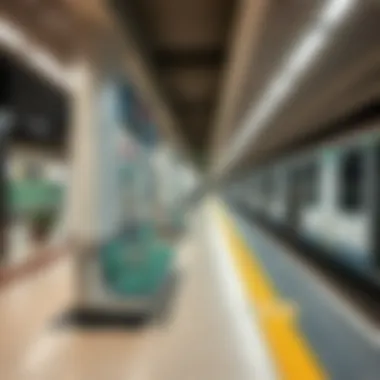
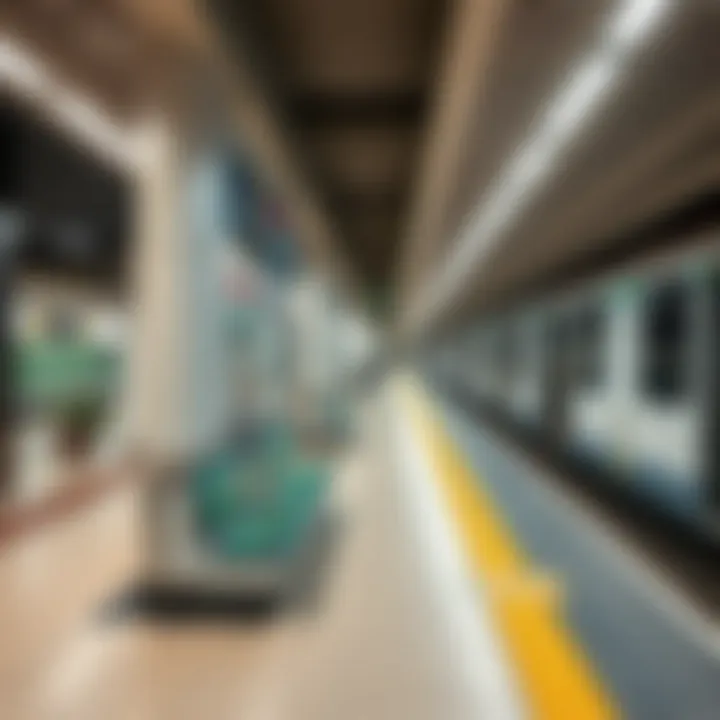
- Urban Expansion and Connectivity: Dubai continually seeks to expand its urban landscape. As connectivity increases, so too will the desirability of properties near metro stations. Developers are keenly aware of this, likely leading to an influx of new housing projects and commercial spaces.
- Gentrification and Commercial Growth: With new transport options comes the potential for gentrification. Existing residents may see property prices increase, while new businesses might sprout in response to increasing foot traffic. A study suggested potential property value growth might reach 10% annually as new infrastructure changes the neighborhood fabric.
- Sustainability Initiatives: The push for sustainable development in logistics and infrastructure also ties into property value dynamics. As environmental consciousness grows, properties will increasingly be evaluated not only for their location but also for their contribution to sustainable living.
Understanding past trends and future forecasts serves as a valuable tool for any investor or homeowner contemplating a purchase or sale near the Salah Al Din Metro Station.
In summary, the enclosed analysis emphasizes that the Salah Al Din Metro Station won’t just enhance urban mobility but has the potential to redefine property values in its vicinity. Investors and homeowners alike should weigh these elements heavily when making decisions about real estate ventures in Dubai's vibrant real estate landscape.
Community Engagement and Local Response
Community engagement is a crucial aspect of evaluating the impact of the Salah Al Din Metro Station on the surrounding area. Engaging local residents and stakeholders helps to cultivate a sense of ownership and pride, which ultimately influences public sentiment and reception of the transit infrastructure. When a community feels heard and valued, they are more likely to be supportive of developments that could enhance their daily lives.
Moreover, the contribution of local residents in the planning and implementation stages can lead to better design choices that reflect the needs and desires of the community. Benefits of such engagement may include fostering greater transparency, creating tailored solutions to unique challenges, and promoting long-term sustainability.
It’s also worth noting that a metro station like Salah Al Din serves as a catalyst for transformation, impacting usage patterns of local resources, services, and infrastructure. Thus, understanding community responses can provide valuable insights into the societal dynamics at play.
Public Sentiment about the Metro Station
Public sentiment regarding the Salah Al Din Metro Station is largely colored by the benefits it brings to residents, such as improved access to various parts of the city. Many in the community have noted a positive shift in their daily commutes. A survey conducted among frequent users highlighted that roughly 75% of respondents felt that the station has made their travel more efficient. Residents appreciate the reduction in travel time and the increased connectivity to major commercial areas.
However, not all feedback is as rosy. Some community members express concerns about overcrowding during peak hours, as well as the noise associated with increased transit activity. Others mention that while the station enhances mobility, it may also lead to elevated property prices, which could displace long-standing residents.
Engagement channels, like community forums and social media platforms, have facilitated ongoing dialogues, allowing citizens to voice both enthusiasm and apprehension. This feedback loop is essential for policymakers and transit authorities to address issues and celebrate successes as they come.
Local Business Developments
The emerging business landscape around Salah Al Din Metro Station demonstrates the station's tangible influence on the local economy. with increased foot traffic, local enterprises have the opportunity to thrive.
- New cafès and eateries have popped up catering to commuters seeking a quick bite or a place to relax.
- Retail shops that offer convenience goods have flourished, turning into essential stops for daily travelers.
- Service industries, such as dry cleaners and repair shops, are also capitalizing on the influx of residents and workers.
Furthermore, local business associations are leveraging the presence of the metro station to attract investments. Initiatives like community workshops and networking events are being organized to help business owners adapt to the changing market dynamics fueled by the station.
The intersection of increased local commercial activity and public transport infrastructure outlines a symbiotic relationship that can lead to greater economic well-being in the area. Engaging local stakeholders in these discussions remains vital to bolster this growth trajectory, ensuring that the evolution of the neighborhood remains in harmony with its residents' aspirations.
The Salah Al Din Metro Station is not just a transit point; it signifies a shift in the urban landscape, fostering connections between people, places, and businesses.
Epilogue and Future Prospects
The conclusion and future prospects of Salah Al Din Metro Station hold significant weight within the context of this article. As we’ve seen, this metro station is not just a transit point; it plays a crucial role in shaping urban mobility and influencing local development. The architectural brilliance showcased at Salah Al Din is a testament to how public infrastructure can transform cityscapes while providing seamless connectivity for its residents.
In summary, there are several key elements worth hitting home here. Firstly, the station enhances accessibility, making life easier for commuters. The visual appeal stands out, merging functionality with aesthetic beauty. Furthermore, we’ve touched on how such infrastructure impacts local property values and can attract investments. The synergy of these factors makes the station a beacon of modern urban planning, highlighting its importance well beyond its primary function.
The benefits to be gained from understanding these factors cannot be overstated. For investors and stakeholders, recognizing the potential for property development in the adjacent area presents numerous opportunities. With an ever-increasing population in Dubai, the demand for efficient transport solutions will only grow, positioning stations like Salah Al Din at the forefront of future developments.
Looking forward, we can anticipate an expansion of services, improvements in technology, and upgrades to the station that will further enhance the commuter experience. The ongoing commitment to urban infrastructure modernization in Dubai hints at a continued focus on integrating metro systems with surrounding businesses and community needs.
Moreover, as the city's demographics evolve, one can expect Salah Al Din Metro Station to adapt as well. This adaptability could involve updates to services or possibly the exploration of inclusive features that cater to a more diversified user base. The station's vicinity may evolve to accommodate new commercial endeavors, which could enhance its role as a local hub.
In a nutshell, Salah Al Din Metro Station is more than just a transit hub; it’s a vital player in the ongoing narrative of urban evolution in Dubai. Its future prospects promise a blend of innovation, connectivity, and community enhancement, making it a focal point for both residents and investors alike.
"The infrastructure we build today shapes the cities of tomorrow. Recognizing this potential is fundamental for the planning of smart urban areas."
Summary of Key Findings
- Integration in Urban Mobility: Salah Al Din Metro Station is crucial for connecting various neighborhoods and facilitates smooth transportation for the local population.
- Architectural Aesthetics: The design elements contribute significantly to both its functionality and its visual impact, creating an inviting environment.
- Economic Impacts: The station enhances surrounding property values and attracts investment opportunities, promising an upward trend in local real estate.
- Future Growth Potential: Continuous improvements and expansions in metro services indicate a robust future for urban infrastructure.
Implications for Investors
For investors, the implications of Salah Al Din Metro Station cannot go unnoticed. The proximity to such a vital infrastructure is a clear indicator of growth potential. Here are some key considerations:
- Real Estate Investments: Properties near the station are likely to see increased demand, translating into higher rental yields and property values in the coming years.
- Commercial Opportunities: With the improved accessibility, businesses setting up close to the station could benefit immensely from foot traffic, boosting their visibility and revenues.
- Long-term Sustainability: The focus on sustainable urban planning suggests that investments linked to the metro are likely to remain resilient, even as market trends fluctuate.
- Enhanced Lifestyle Offerings: Investors should consider the broader lifestyle changes that come with transit-oriented development—like parks, shops, and recreational facilities, which add value to community living spaces.
By being attuned to these trends and understanding the implications of metro infrastructure such as the Salah Al Din Station, investors can position themselves strategically within the heart of Dubai’s vibrant real estate market.











